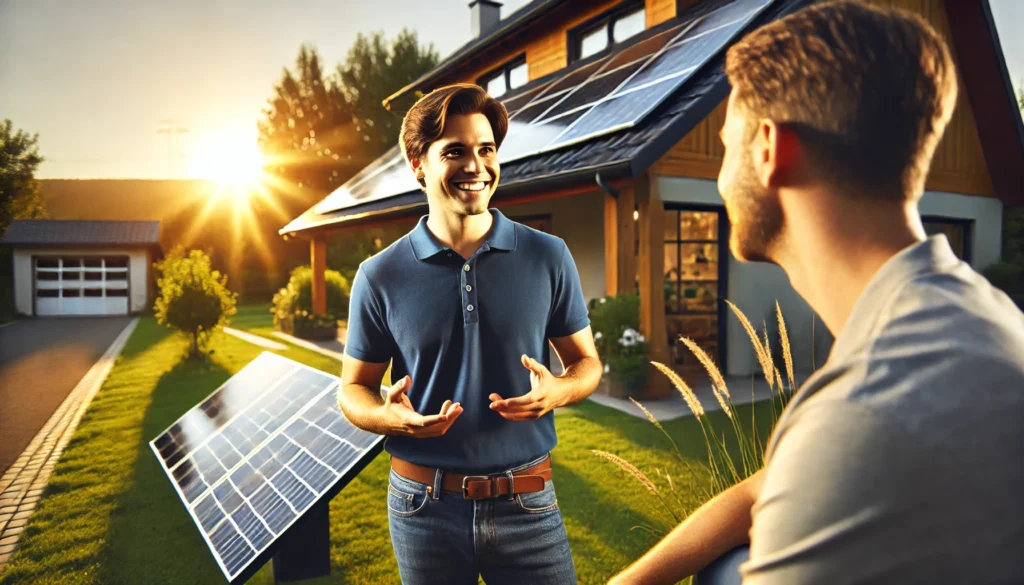Building Trust and Connection: Using Storytelling to Close More Solar Deals
In the competitive world of solar sales, numbers and financial data play a crucial role—but they’re not always enough to win over customers. While payback periods, energy savings, and tax incentives are important, what truly inspires action is emotion. And nothing taps into emotion better than storytelling.
A well-told story makes solar energy relatable, personal, and impactful. By sharing real-life examples of successful installations, environmental benefits, and community-driven change, you can create a deep connection with your prospects and transform their skepticism into enthusiasm.
Here’s how you can use storytelling to build trust, engage customers, and close more solar deals.
1. The Power of Storytelling in Solar Sales
People remember stories far better than facts and figures. When someone is presented with a story they can relate to, they experience it on a personal level.
Why Storytelling Works in Sales:
✅ Builds Trust – Prospects see real-world examples, making solar seem more attainable.
✅ Creates Emotional Connections – People act based on emotions, not just logic.
✅ Makes Solar Personal – Hearing about a neighbor’s success makes homeowners more likely to buy.
✅ Overcomes Skepticism – A compelling story can ease concerns better than a spreadsheet.
Example: Instead of saying,
“Solar panels can reduce your electricity bill by up to 70%,”
tell them a story:
“Sarah, a single mother in Arizona, was struggling with high energy bills. After installing solar, she cut her bill from $250 to just $30 per month—freeing up money for her kids’ education.”
A story like this creates a vivid picture of how solar changes lives.
2. How to Structure a Compelling Solar Sales Story
A strong story follows a simple yet powerful structure:
🔹 Step 1: Introduce the Hero (Your Customer)
Who is your customer? Homeowners relate better to people who share similar experiences.
✅ Are they a family struggling with high energy bills?
✅ A business owner looking for sustainable solutions?
✅ An environmentally conscious homeowner wanting to reduce their carbon footprint?
Make the hero relatable so your prospects can see themselves in the story.
🔹 Step 2: Highlight Their Challenge
Every great story has a problem to solve. What issue did your customer face before going solar?
✅ Skyrocketing utility bills?
✅ Frustration with unpredictable energy costs?
✅ A desire to be more environmentally responsible?
This sets up the pain point—something your prospect may also be experiencing.
🔹 Step 3: Present the Solar Solution
Now, introduce how solar transformed their situation.
✅ How did they learn about solar?
✅ What financing option made it affordable?
✅ How did the installation process go?
This part should make solar seem like a clear and stress-free solution.
🔹 Step 4: Showcase the Results (The Happy Ending)
How did life improve after going solar?
✅ Lower energy bills?
✅ More financial freedom?
✅ A reduced carbon footprint?
Make sure to include real numbers and emotional benefits to make the impact feel tangible.
Example:
“Mark and Lisa installed solar last year. Their monthly electric bill dropped from $300 to just $40, and now they’re using the savings to travel more with their kids. Their only regret? Not going solar sooner!”
3. Types of Stories That Resonate with Homeowners
Different prospects are motivated by different things. Use targeted storytelling to appeal to various customer priorities.
🔹 Financial Savings Story (For Budget-Conscious Customers)
- Focus on how solar reduces monthly expenses.
- Highlight tax credits, financing options, and ROI.
- Example: “Tom’s mortgage went up, but thanks to solar savings, he kept his monthly costs the same!”
🔹 Environmental Impact Story (For Eco-Conscious Buyers)
- Share how switching to solar helps reduce carbon emissions.
- Include statistics like tons of CO₂ saved or the equivalent of planting trees.
- Example: “The Johnson family went solar and reduced their carbon footprint by the equivalent of taking 3 cars off the road each year!”
🔹 Community Impact Story (For Local Engagement)
- Talk about neighborhoods embracing solar together.
- Mention community savings and group discounts.
- Example: “In this neighborhood, 20 families have gone solar in the last year, saving a combined $50,000 on electricity!”
🔹 Energy Independence Story (For Those Tired of Utility Companies)
- Discuss avoiding rising energy costs and gaining control over power usage.
- Example: “After experiencing multiple power outages, Jane installed solar with battery backup—now her home stays powered no matter what.”
By tailoring the right story to the right customer, you speak directly to their motivations.
4. How to Deliver Stories Effectively
Great stories only work if they’re delivered well. Here’s how to make sure your storytelling engages and persuades:
✅ Keep It Conversational – Avoid a sales pitch; talk naturally like you’re telling a friend.
✅ Use Visuals – Show photos, before-and-after energy bills, or testimonials.
✅ Encourage Engagement – Ask, “Can you relate to this situation?” to involve prospects in the story.
✅ Let Customers Tell Their Stories – Share video testimonials or invite potential buyers to talk with past solar customers.
Example Pitch:
“Let me tell you about one of my customers, David. He was skeptical about solar, just like you. But after seeing his first bill drop by 80%, he called me and said, ‘Why didn’t I do this sooner?’”
Stories like these build trust and make solar feel like an easy, logical decision.
5. Turning Stories into Sales
Once you’ve drawn your prospect in with storytelling, transition smoothly into closing the deal.
🚀 Closing the Sale with Storytelling:
🔹 Reinforce the Emotional Hook:
“Imagine being in Mark and Lisa’s position—saving $250/month while helping the environment.”
🔹 Connect Their Story to a Call-to-Action:
“Would you like to see how much you could save, just like they did?”
🔹 Offer a Personalized Assessment:
“Every home is different, so let’s look at your numbers. I’ll put together a savings estimate for you right now.”
Using storytelling as a bridge between emotion and action helps prospects make confident, motivated decisions.
Final Thoughts: The Power of Storytelling in Solar Sales
Solar sales isn’t just about selling panels—it’s about selling transformation. By using storytelling, you can:
✅ Build trust and make solar more relatable.
✅ Engage prospects emotionally, not just logically.
✅ Overcome objections through real-world examples.
✅ Motivate customers to take action by showing the human side of solar.
In the end, people buy from those they trust. If you can connect with them through stories, you won’t just close more deals—you’ll create lasting relationships and empower more people to go solar. 🌞🚀
So, what’s your next solar success story? Start sharing it today!
Ready to be part of the energy revolution?
Become a Solar Sales Representative with Shyne Solar
Earn great commissions and let Shyne handle the process, installation, maintenance, and support!
Register Now!
